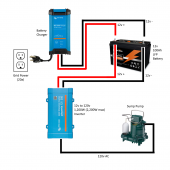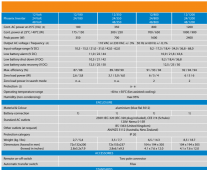monochromatic
New Member
- Joined
- Oct 28, 2022
- Messages
- 18
Hi, I have a 110v sump pump that I'd like to run off battery when the power goes out. Unfortunately I don't have room for a 12v backup pump in the sump pump pit.
After considering lots of options, I'm wondering if I can do the following:
Thanks!
After considering lots of options, I'm wondering if I can do the following:
- Victron Phoenix 12/1200 inverter connected to the sump pump
- Inverter connected to a 12v LiFePo4 100Ah battery
- Victron Smart Blue charger connected to the battery
Thanks!




